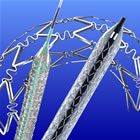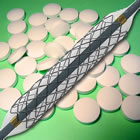For the interventionalist, proper sizing of coronary stents is critical. While imaging via angiography has been the standard for years, newer intravascular imaging technologies, such as IVUS and OCT, are becoming more widely used, as evidence accrues that these modalities make a difference in outcomes. For example, IVUS (Intravascular Ultrasound) not only allows the measurement of the exact open diameter of the vessel, as seen on angiography, but it shows the “invisible to angiography” layer of plaque. plaque that will be compressed, so that a more accurate post-PCI diameter can be determined. Under-expanded stents have been associated with increased stent thrombosis and restenosis. Continue reading
Category Archives: Drug-Eluting Stents
Post-Dilatation Stent Sizes
Filed under Angiograms, Drug-Eluting Stents, Imaging, IVUS, OCT, Stent, Stent Thrombosis
George W. Bush Gets Angioplasty and Stent – Was It Necessary?
 Former President George W. Bush received an angioplasty and stent this morning at Texas Health Presbyterian Hospital Dallas. The stent was recommended by Bush’s doctors to open a blockage in one of his coronary arteries, found yesterday during what was described by Bush spokesman Freddy Ford as his annual physical exam at the Cooper Clinic in Dallas. Continue reading
Former President George W. Bush received an angioplasty and stent this morning at Texas Health Presbyterian Hospital Dallas. The stent was recommended by Bush’s doctors to open a blockage in one of his coronary arteries, found yesterday during what was described by Bush spokesman Freddy Ford as his annual physical exam at the Cooper Clinic in Dallas. Continue reading
Stent Wars, the Prequel: PROMUS Element “Beats” Xience
 Sorry Jar-Jar. We all know that Episodes 1-3 of “Star Wars” just didn’t cut it when compared with the original trilogy. Although these prequels were technically more sophisticated, and the digital rendering was way more advanced, the stories were just…boring.
Sorry Jar-Jar. We all know that Episodes 1-3 of “Star Wars” just didn’t cut it when compared with the original trilogy. Although these prequels were technically more sophisticated, and the digital rendering was way more advanced, the stories were just…boring.
I started the wordplay about “Stent Wars” over a decade ago, a time when the competitive juices of the two device-makers, Boston Scientific and J&J/Cordis, were at an all time peak — each company was heavily marketing their first generation drug-eluting stent and every interventional cardiology meeting was saturated with “Cypher vs. Taxus” messaging. Continue reading
Filed under Drug-Eluting Stents, Stent, Stent Wars


 At this week’s annual European Society of Cardiology Congress in Rome, an important randomized clinical trial on stents was presented by Professor Kaare H. Bønaa, MD, PhD of the Clinic for Heart Disease, St. Olav’s University Hospital in Trondheim, Norway. Called NORSTENT, short for the “Norwegian Coronary Stent Trial,” this was the largest stent trial ever conducted, with 9,013 patients followed for six years. That’s serious!
At this week’s annual European Society of Cardiology Congress in Rome, an important randomized clinical trial on stents was presented by Professor Kaare H. Bønaa, MD, PhD of the Clinic for Heart Disease, St. Olav’s University Hospital in Trondheim, Norway. Called NORSTENT, short for the “Norwegian Coronary Stent Trial,” this was the largest stent trial ever conducted, with 9,013 patients followed for six years. That’s serious!  This past week saw publication of an update to the 2007 COURAGE trial which compared optimal medical therapy (OMT) to stenting (PCI) as the initial management strategy for stable coronary artery disease. (Please note the phrase “initial management strategy.” This will not be the last time you see it in this post.)
This past week saw publication of an update to the 2007 COURAGE trial which compared optimal medical therapy (OMT) to stenting (PCI) as the initial management strategy for stable coronary artery disease. (Please note the phrase “initial management strategy.” This will not be the last time you see it in this post.) No one thought it would take quite so long to get this information, but in just a couple hours results from
No one thought it would take quite so long to get this information, but in just a couple hours results from 


